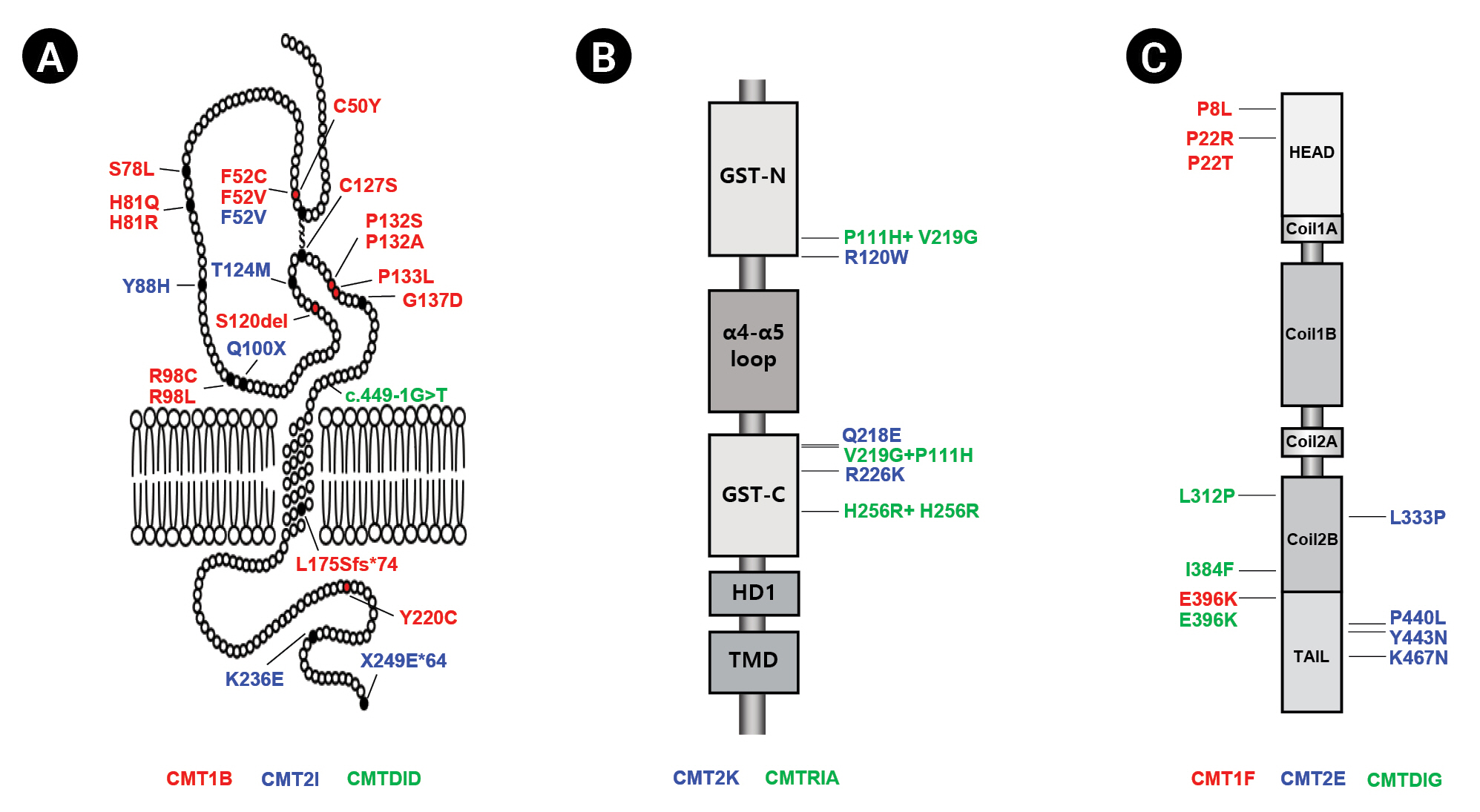 |
 |
- Search
| J Electrodiagn Neuromuscul Dis > Volume 24(3); 2022 > Article |
|
Abstract
Fig.┬Ā1.

Table┬Ā1.
Table┬Ā2.
| Gene | Population |
Frequency |
Reference | |
|---|---|---|---|---|
| Total CMT patients (%) | CMT patients excluding CMT1A (%) | |||
| MPZ | Korean | 3.2 | 4.7 | [34] |
| Chinese | 3.3 | 6.4 | [26] | |
| Japanese | 5.1 | NA | [29] | |
| German | 4.2 | 6.4 | [31] | |
| British | 3.1 | 5.1 | [27] | |
| American | 4.1 | 6.5 | [35] | |
| Spanish | 4.3 | 7.5 | [32] | |
| Italian | 4.3 | 12.3 | [33] | |
| Hungarian | 4.5 | 7.5 | [36] | |
| Norwegian | 6.0 | NA | [37] | |
| Russian | 3.5 | 5.2 | [21] | |
| Finnish | 5.2 | NA | [38] | |
| Austrian | 4.0 | NA | [39] | |
| GDAP1 | Korean | 0.7 | 1.0 | [40] |
| Chinese | NA | 1.6 | [30] | |
| Japanese | NA | 0.9 | [29] | |
| British | 0.5 | 0.8 | [27] | |
| American | 0.7 | 1.6 | [28] | |
| Spanish | 11.1 | 20.7 | [32] | |
| Italian | 5.4 | 11.0 | [33] | |
| NEFL | Korean | 1.5 | 2.1 | [41] |
| Chinese | 1.9 | 3.7 | [26] | |
| Japanese | 0.9 | NA | [29] | |
| 2.3 | 2.7 | [23] | ||
| German | 0.0 | 0.0 | [31] | |
| 0.1 | 0.1 | [42] | ||
| British | 0.2 | 0.2 | [27] | |
| American | 0.7 | 1.6 | [28] | |
| 0.7 | 1.1 | [35] | ||
| 0.5 | 0.8 | [43] | ||
| Spanish | 0.9 | 1.6 | [32] | |
| Italian | 0.6 | 1.8 | [33] | |
| Norwegian | 0.7 | NA | [37] | |
Table┬Ā3.
All data are expressed as the mean ┬▒ standard deviation. Normal nerve conduction velocity values: motor median nerve Ōēź 50.5 m/s; sensory median nerve Ōēź 39.3 m/s; sural nerve Ōēź 32.1 m/s. Normal amplitude values: motor median nerve Ōēź 6 mV; sensory median nerve Ōēź 8.8 ╬╝V; sural nerve Ōēź 6.0 ╬╝V.
CMT, Charcot-Marie-Tooth disease; ANOVA, analysis of variance; CMTNS, CMT neuropathy score; FDS, functional disability scale; CMAP, compound muscle action potential; MNCV, motor nerve conduction velocity; SNAP, sensory nerve action potential; SNCV, sensory nerve conduction velocity.
Table┬Ā4.
All data are expressed as the mean ┬▒ standard deviation. Normal nerve conduction velocity values: motor median nerve Ōēź 50.5 m/s; sensory median nerve Ōēź 39.3 m/s; sural nerve Ōēź 32.1 m/s. Normal amplitude values: motor median nerve Ōēź 6 mV; sensory median nerve Ōēź 8.8 ╬╝V; sural nerve Ōēź 6.0 ╬╝V.
CMT, Charcot-Marie-Tooth disease; ANOVA, analysis of variance; CMTNS, CMT neuropathy score; FDS, functional disability scale; CMAP, compound muscle action potential; MNCV, motor nerve conduction velocity; SNAP, sensory nerve action potential; SNCV, sensory nerve conduction velocity.
Table┬Ā5.
All data are expressed as the mean ┬▒ standard deviation. Normal nerve conduction velocity values: motor median nerve Ōēź 50.5 m/s; sensory median nerve Ōēź 39.3 m/s; sural nerve Ōēź 32.1 m/s. Normal amplitude values: motor median nerve Ōēź 6 mV; sensory median nerve Ōēź 8.8 ╬╝V; sural nerve Ōēź 6.0 ╬╝V.
CMT, Charcot-Marie-Tooth disease; ANOVA, analysis of variance; CMTNS, CMT neuropathy score; FDS, functional disability scale; CMAP, compound muscle action potential; MNCV, motor nerve conduction velocity; SNAP, sensory nerve action potential; SNCV, sensory nerve conduction velocity.







